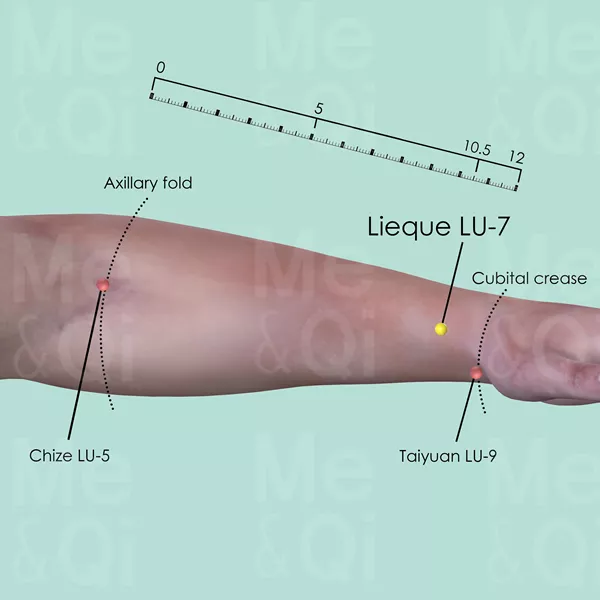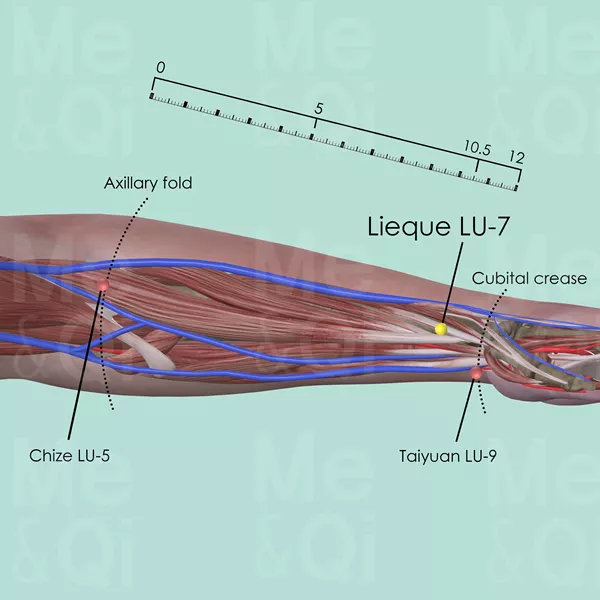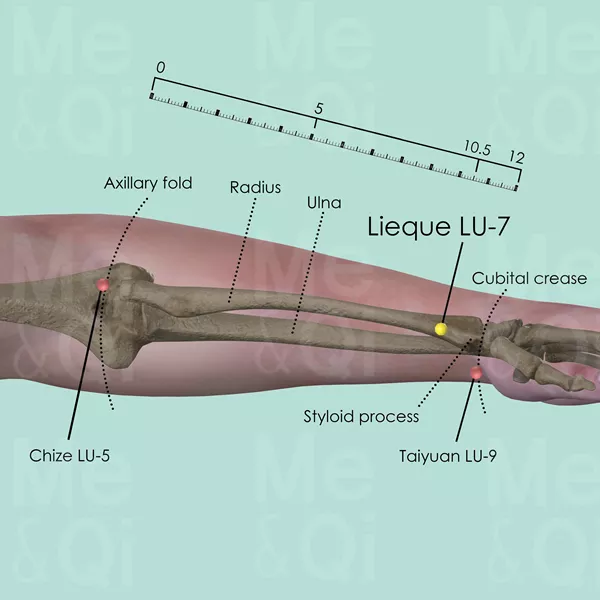Lieque LU-7
Chinese: 列缺
Pinyin: Liè quē
Location
Above the styloid process of the radius, about 1.5 cun proximal to the wrist crease (wrist joint space) in a V-shaped depression.
How to locate
When the index fingers and thumbs of both hands are crossed with the index finger of one hand placed on the styloid process of the radius of the other, the point is in the depression right under the tip of the index finger.
Main actions
- Descends and diffuses the Lung Qi
- Expels Wind from the Exterior
- Opens the Directing Vessel
- Opens water passages and benefits the Bladder
Indications
Needling
Insert obliquely upward 0.3-0.5 cun.
Locate the point by lifting the skin above the styloid process by pinching it. After getting the Qi, proximally push the needle to reduce it, or distally pull the needle to tonify the Qi.
Commentary for Lieque LU-7
The Lungs control the space between the skin and muscles (腠里 Cou Li Space), where the Defensive Qi circulates. They also disperse Body Fluids in this space like a mist, so as to moisten the muscle, tendon and skin. They control the pore opening to releases excessive Body Fluids in form of sweating.
Lieque LU-7 is a very important point, because it stimulates the Lung Qi descending and diffusing, enhances the Defensive Qi flow between the skin and muscle and releases external Pernicious Influences (mainly Wind-Cold or Wind-Heat) from the Exterior through sweating.
It is often used together with Hegu LI-4 in the beginning stages of the common cold or influenza characterized by stiff neck, sneezing, headache, aversion to cold and fever. The pulse is normally Floating. The combination of these two points are called 'Guest-Host', because the Lung Divergent Channel (the 'Guest') connects with the Large Intestine Primary Channel (the 'Host').
In fact, LU-7 is the connecting point for the Lung and Large Intestine Channel, so it is very effective in treating both Channel problems. For example, it is frequently used (on the opposite side) as a distal point for Painful Obstruction Syndrome of the shoulder, if the issue is along the Large Intestine Channel. Often among the elderly, it is used to tonify Lung Qi and direct it to the Large Intestine to treat constipation or difficulties to pass stools.
In additional to Exterior patterns above, it is widely used for Interior patterns as well. In fact, due to its impact on descending Rebellious Lung Qi, it is the best point of the Lung Channel in treating all types of cough or asthma, regardless being acute or chronic.
Together with Yingxiang LI-20, Lieque LU-7 also treats nose related symptoms such as nasal obstruction, runny nose, sneezing, sense of smell loss or even allergic rhinitis. It is because the Lungs open the nose and diffuses Lung Qi there.
It also treats psychological and emotional issues, especially these caused by grief, sadness or worry. Lungs are the Organs most vulnerable to these. Patients suppressing these feelings inside may burst out crying after this point is used, because weeping is the sound associated with the Lungs according to the Five Elements Theory.
Prolonged excessive worry prevents the free breath of the Corporeal Soul (魄 Po) and constrains the Lung energy, resulting in some physical symptoms such as tense shoulder, shallow breathing and feeling of chest oppression. Outpouring of these repressed emotions is beneficial. LU-7 helps to settle the Corporeal Soul housed in the Lungs and calms the Mind housed in the Heart, therefore the chest is opened and tension is released.
Although LU-7 is mainly used to stimulate Lung Qi descending, it is also able to direct Clear Qi up to the Heart and head to treat poor memory, palpitations, crying, frequent yawning as well as propensity to inappropriate laughter. It is because the Mind and Corporeal Soul are nourished by Clear Qi.
It is often used to treat headaches when combining with other points, because it is one of the most useful points in direct other points' effect to the face and head.
Another very important feature of LU-7 (together with Zhaohai KI-6) is its ability to open Directing Vessel (任脉 Ren Mai), which is the key Vessel for any gynaecology issues, particularly of the external genitalia or after labor. Thanks to its character of simulating Qi descending, it is effective in expulsion of lochia or of a dead fetus.
The combination of LU-7 and KI-6 only only descends Lung Qi, but also stimulates the Kidney function of receiving Qi. Therefore they can treat chronic asthma from Lung and Kidney Yin Deficiency. Together, they are able to nourish Yin so as to regulate the Uterus and its menstrual function as well as moisten the throat and eyes.
Of the Lung Channel, LU-7 is the major point in controlling water passage opening, because the Lungs and the Bladder are connected indirectly. When the descending of Lung Qi is impaired due to external Pernicious Influences (Full pattern) or Lung Qi Deficiency (Empty pattern), the water passage to the Bladder is obstructed, resulting in symptoms such as urinary retention or face Oedema. The Empty type is more common among the elderly and Tonifying Needle Method should be applied here. Otherwise, Reducing Needle Method should be used in Full patterns.
Finally, the combination of Lieque LU-7 and Fenglong ST-40 is used frequently to resolve Phlegm in the Lungs as both points impact the chest. LU-7 simulates Qi descending so as to open water passage and remove Phlegm, while ST-40 opens chest and removes Phlegm in general. It is recommended to use these two points in the opposite side. For example, ST-40 on the right and LU-7 on the left or vice versa.



